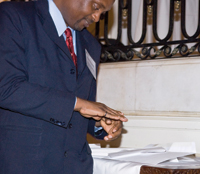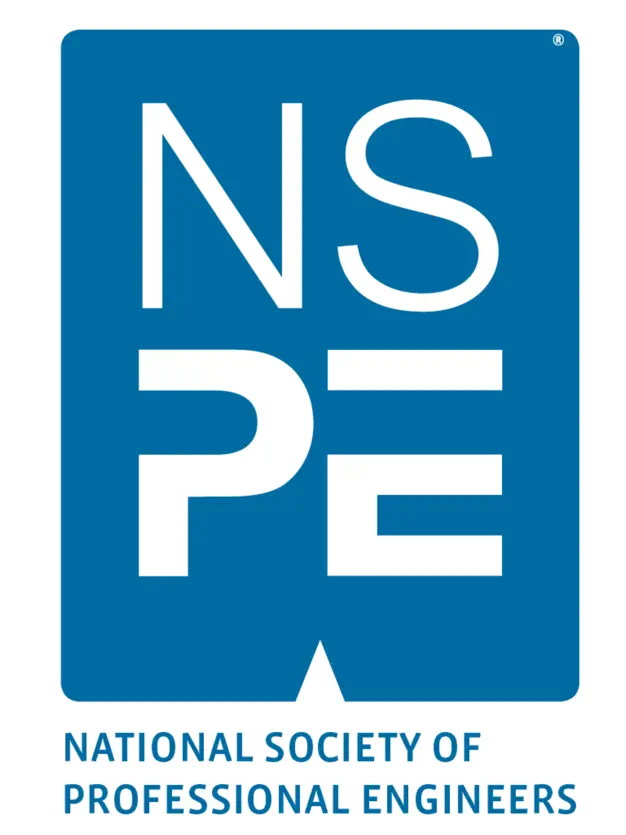July 2009
Called to Order
Order of the Engineer inductees wear a stainless steel ring on the little finger of their working hand as a visible reminder of the oath of integrity and ethics that they've taken. Last year about a third of engineering seniors took the oath, but there are still plenty of engineers who haven't had the opportunity.
BY EVA KAPLAN-LEISERSON
 |
|
Frank Onovae, P.E., a telecommunications engineer and member of the Maryland Society of Professional Engineers, examines his new Order ring at the MSPE PE Recognition Event last September. |
It's a solemn ritual that counts astronaut Neil Armstrong among its participants. The Order of the Engineer ceremony is not yet a standard part of milestones such as graduating with an engineering degree or receiving the PE license, but a growing number of institutions and engineering societies are adopting the ceremony—so one day it may be.
In the Order's ceremony, engineers take the Obligation of the Engineer oath and receive a stainless steel ring to wear on the little finger of their working hand. The aim of the Order is "to foster a spirit of pride and responsibility in the engineering profession, to bridge the gap between training and experience, and to present to the public a visible symbol identifying the engineer." With limited exceptions, inductees must be graduates of ABET-accredited engineering programs, seniors in such programs, or PEs.
The Order is tied closely to NSPE. According to Building for Professional Growth: A History of the National Society of Professional Engineers 1934?1984 by Paul Robbins, P.E., former Ohio Society President Homer Borton, P.E., played a key part in designing the Order of the Engineer ceremony. Part of the Obligation of the Engineer pledge is modeled after NSPE's Engineers' Creed.
In addition, NSPE became a vehicle for extending the ring ceremonies throughout the U.S. via its chapters and state societies, Robbins writes. Currently, 20 local sections or "links" permitted to perform the ceremony are associated with the Society, including NSPE's Professional Engineers in Government, about 15 state societies, and several local and university chapters. Two members of the Order of the Engineers 2008?09 Board of Governors are also past presidents of NSPE: Monte Phillips, P.E., F.NSPE, and Donald Hiatte, P.E., F.NSPE.
In total, there are 258 Order of the Engineer links with 10 potential links in process. More than 300,000 engineers around the country have taken the Obligation of the Engineer oath.
History
The Order of the Engineer ceremony was modeled after Canada's Ritual of the Calling of the Engineer. That ceremony began in 1926, using a wrought iron ring and an oath written by poet Rudyard Kipling. As a common legend goes, the iron for the first rings was collected from the wreckage of the Quebec Bridge, which collapsed twice during construction in the early 1900s and killed more than 80 people. As an article in the October 2001 Engineering Times explains, according to legend, using materials from the failed bridge for the rings reminded Canadian engineers to be humble.
However, according to Jacob Jeswiet, a professor in the mechanical engineering department at Queen's University in Ontario who was cited in the Engineering Times article, that story is a myth. Jeswiet's research indicates that the rings were never made from the bridge materials, nor were they meant to be a reminder of the collapse. Instead, Jeswiet said, the iron ring ceremony was set in motion in 1922 when seven Montreal engineers met to discuss professional solidarity and the engineer's societal responsibilities. They then asked Kipling to write the ceremony because he had referred to engineers in some of his work.
A Canadian engineer who was on the staff at Purdue University, which has been conducting the Order of the Engineer ceremony since the early 1970s, explained to Purdue's longtime Order coordinator and member Robert Jacko, P.E., that in Canada the iron ring is prized by engineering graduates even more than their diploma. "They place a tremendous amount of value on the receipt of the ring," explains Jacko, professor of civil engineering.
How did the ceremony come to the U.S.? In the 1960s, several officers of the Ohio Society of Professional Engineers wanted to bring the Canadian Ritual of the Calling of the Engineer to this country. However, due to copyright restrictions and other legal concerns, transplanting the ritual was not possible. Instead, it was used to inspire a U.S. version. Cleveland State University held the first Order of the Engineer ceremony in 1970. The Order of the Engineer organization was incorporated in Ohio in 1972. It is currently headquartered in Scottsdale, Arizona.
The Ceremony and Its Meaning
The Maryland Society of Professional Engineers has been conducting the Order of the Engineer ceremony since 1974. MSPE performs the ceremony twice a year in combination with its PE Recognition Event, which welcomes newly licensed PEs to the profession. Usually participants include newly licensed engineers and a few older engineers who took the oath in college and would like to renew it, explains MSPE Executive Director Bob Mead.
In February 2009, about 25 engineers participated. "[The ceremony] really dramatizes the professionalism," Mead notes. "It's a very impressive ceremony, and people take it very seriously. And that's what we're about: professionalism."
Mandatory elements of the program include explanations of the history of the Order and the significance of the ring. Following those brief speeches—in MSPE's case, given by members of its link board of governors—participants take the Obligation of the Engineer oath, which is similar to the Hippocratic Oath for doctors. In taking the pledge, engineers swear to practice integrity and honesty, serve humanity, and "give the utmost."
In many Order ceremonies, engineers place their working hand through a large wooden or steel ceremonial ring and receive the stainless steel ring on their smallest finger. According to the Order, "this commitment is not a trival act, but is, rather, like the wedding of the engineer with his profession."
The Order explains that the ring is a visible symbol of the wearer's calling, symbolizing the unity of the profession in its goal of helping mankind. The stainless steel from which the ring is made represents the strength of the profession. In addition, according to the Order, the placement of the ring is a visible reminder of inductees' obligation to the public's health, safety, and welfare when they sign or stamp documents or specifications.
The ring reminds members to check and recheck their calculations before signing their name, a sample address from the Order states. "The success of the engineering project and the lives of people may depend on your engineering work."
Also included in the ceremony is a brief speech on the responsibilities, ethics, and obligation of engineering. Jacko explains that at the Purdue ceremony, a leader from industry may give this "speech of charge" to the graduates.
About 15,000 Purdue engineers have participated in the Order ceremony over the years, including Neil Armstrong. Jacko recently passed the torch for conducting the Order ceremonies after more than 15 years to Vince Drnevich, P.E., professor of civil engineering at Purdue and president of the Indiana Society of Professional Engineers.
The Order is not a membership association, and it has no dues. Instead, it "fosters a unity of purpose and the honoring of one's pledge lifelong," according to the organization. J. Derald Morgan, P.E., chair of the Order's 2008?09 National Board of Governors, explains that just as engineering students complete a capstone design project, "[joining the Order of the Engineer] is kind of the capstone of?being a professional and using your skills and capabilities in an ethical, professional manner."
State Societies
The Minnesota Society of Professional Engineers has been performing the Order of the Engineer ceremony since its annual meeting in 1978. MSPE conducts the ritual every couple of years for its own members who want to join or renew their pledge, but also provides rings for ceremonies linked to graduation at the University of Minnesota, the University of Minnesota Duluth, the University of St. Thomas in St. Paul, and Minnesota State University, Mankato.
Katie Jamieson, MSPE's director of member services, explains that for MSPE, the Order of the Engineer is "important as a part of who we are and what we do in promoting ethical practices."
MSPE member Kent Schneider, a mechanical engineer at Newmech Companies Inc., has conducted the ceremonies at the University of Minnesota and University of St. Thomas for over 10 years. More than 150 graduating engineers are inducted each year in those ceremonies, he notes. Schneider says he's always looking for ways to reinforce ethics. "With the ring on your finger that you look at every day, it reinforces it pretty well," he says.
The Louisiana Engineering Society became a link for the Order of the Engineer earlier this year. Its first ceremony was several years ago when Texas Order members conducted a ceremony for LES at its centennial celebration, but LES's first ceremony as a link was this January. Members of LES who were in the Order pushed for the opportunity for others to join, explains the society's executive director, Brenda Gajan. About 15 engineers participated. It was important for LES to become a link because the Order reinforces that commitment to the profession, Gajan says.
Gale Field, senior meeting planner at the Florida Engineering Society, which has been performing the Order of the Engineer ceremony since 1980, points out another benefit of the Order. "It increases public recognition of the profession of engineering," she says.
Why They Participate
Sal Bono, P.E., principal of SB Design Engineering near Albany, New York, learned about the Order from a colleague and joined about six years ago. "After going to the Web site and reading the oath and what it was all about, I realized this is why I became an engineer," he says.
Bono conducted the ceremony for the New York State Society of Professional Engineers during Engineers Week 2009. The more he read the oath in preparing for the ceremony, the stronger he felt about it, he says.
Engineering skills come with responsibilities, Bono explains. "Engineering is not just a person performing calculations. It's getting the whole society to interact more efficiently, more effectively, and to improve the quality of life," he says. "It's not just a job?. We impact people's lives in ways they don't even realize."
Craig D'Allaird, P.E., an instructor at Hudson Valley Community College in upstate New York, was one of the engineers inducted at February's EWeek event. He wanted to join because he teaches ethics. "I felt the Order and the pledge you take are?meaningful, relevant, and necessary. [The pledge] encompasses everything we learn in school," he says. "I wanted to do the Order and promote it more to my students."
Ethics isn't emphasized enough in most engineering programs, D'Allaird believes. "It can be overlooked easily. Especially nowadays when finances are tight, people are a little more willing to look the other way," he says. "We can't have that. The profession needs to be trusted."
Giurgiu Murgurel, P.E., inductee at the MSPE ceremony in Baltimore this year, compares the ceremony to pledging allegiance to the flag or joining the Army. "It's something to do from your heart," he says. "You want to do it because you want to be part of something big. It's like your life has a goal."
Expanding the Order
Morgan explains that the organization is focusing on encouraging young engineering graduates to join the Order. Last year, about one in three engineering seniors nationwide joined, Morgan says, but that's up from maybe 1-in-20 at one time. "I'd like to see that number be two-in-three," he says, "and we're working on that."
One of the issues is that not every university with an engineering program has a link, he explains. "We need to encourage every dean and department head and program head to take it upon themselves to make sure that the students they're so proud of have the opportunity to become a member of the Order," he says.
Each member of the Order's Board of Governors oversees several active links to ensure that they are conducting ceremonies and have the materials they need. Each governor is also assigned 5?10 universities that don't have a link to attempt to encourage deans or program directors to establish one. "It becomes very much the leadership of the university that makes a difference," says Morgan.
In addition, according to the organization, the ceremony will continue to be held for older engineers "until there is a preponderance of practicing engineers in the U.S. who have participated." Morgan says he regularly receives e-mail from people who didn't get an opportunity to join a link in college and would like to know how to do so. He then connects them with a link run by an NSPE state society, university, or other engineering organization.
"Once [engineers] have gone through the ceremony, I think it gives them a feeling of union, a sense of community," says FES's Gale Field. Robert Jacko tells students, "If you're on an aircraft flying to Iraq?and when you get there you see someone wearing a steel ring on the small finger of their working hand, chances are that's an Order of the Engineer ring, and it's a wonderful networking tool."
For more information on the Order, including a list of local links, visit www.order-of-the-engineer.org. If you'd like to start or reactivate an Order of the Engineer link at your state society, chapter, or institution, contact Paula Ostaff at 866-364-7464 or [email protected].
|
Obligation of the Engineer The following is the oath that engineers take to join the Order of the Engineer: I am an Engineer, in my profession I take deep pride. To it I owe solemn obligations. Since the Stone Age, human progress has been spurred by the engineering genius. Engineers have made usable Nature's vast resources of material and energy for Humanity's benefit. Engineers have vitalized and turned to practical use the principles of science and the means of technology. Were it not for this heritage of accumulated experience, my efforts would be feeble. As an Engineer, I pledge to practice integrity and fair dealing, tolerance and respect, and to uphold devotion to the standards and the dignity of my profession, conscious always that my skill carries with it the obligation to serve humanity by making the best use of Earth's precious wealth. As an Engineer, I shall participate in none but honest enterprises. When needed, my skill and knowledge shall be given without reservation for the public good. In the performance of duty and in fidelity to my profession, I shall give the utmost. Used by permission of The Order of the Engineer Inc. |


 Volunteering at NSPE is a great opportunity to grow your professional network and connect with other leaders in the field.
Volunteering at NSPE is a great opportunity to grow your professional network and connect with other leaders in the field. The National Society of Professional Engineers (NSPE) encourages you to explore the resources to cast your vote on election day:
The National Society of Professional Engineers (NSPE) encourages you to explore the resources to cast your vote on election day: